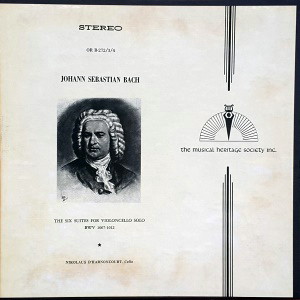 |
3 LP -
OR B-272/3/4 - (p) 1965
|
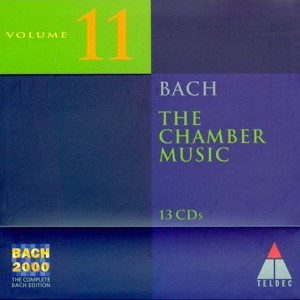 |
| 13 (2)
CD - 3984-25716-2 - (c) 1999 |
|
| Johann Sebastian
Bach (1685-1750) |
|
|
|
|
|
|
|
| The Six Suites for
Violoncello Solo, BWV 1007-1012 |
|
|
|
|
|
|
|
| SUITE No. 1 in G
MAJOR, BWV 1007 |
|
17' 56" |
A1 |
| - (Prelude -
Allemande - Courante - Sarabande -
Menuett I & II - Gigue) |
|
|
|
| SUITE No. 2 in D
MINOR, BWV 1008 |
|
20' 08" |
B1 |
| - (Prelude -
Allemande - Courante - Sarabande -
Menuett I & II - Gigue) |
|
|
|
| SUITE No. 3 in C
MAJOR, BWV 1009 |
|
22' 56" |
C1 |
| - (Prelude -
Allemande - Courante - Sarabande -
Bourree I & II - Gigue) |
|
|
|
| SUITE
No. 4 in E-FLAT MAJOR, BWV 1010 |
|
22' 53" |
D1 |
| - (Prelude -
Allemande - Courante - Sarabande -
Bourree I & II - Gigue) |
|
|
|
| SUITE
No. 5 in C MINOR, BWV 1011 |
|
24' 55" |
E1 |
| - (Prelude -
Allemande - Courante - Sarabande -
Gavotte I & II - Gigue) |
|
|
|
| SUITE
No. 6 in D MAJOR, BWV 1012 |
|
27' 47" |
F1 |
| - (Prelude -
Allemande - Courante - Sarabande -
Gavotte I & II - Gigue) |
|
|
|
|
|
|
|
Nikolaus
D'Harnoncourt, Cello
|
|
| -
Andrea Castagneri, Paris, 1744
(BWV 1007-1011) |
|
| -
Violoncello piccolo Baer,
Salsburg, mid 17th century (BWV
1012) |
|
|
Luogo e data
di registrazione
|
Josefstädterstrasse 17, Vienna
(Austria) - 1965
|
|
Registrazione
live / studio
|
| studio |
Producer / Engineer
|
Dr. Kurt List / Syd Taylor,
Tape editor (Columbia Studios)
|
Prima Edizione
CD
|
Teldec "Bach 2000" -
3984-25716-2 - [13 cd (cd's 5 & 6)]
- 61' 47" + 78' 49" - (c) 1999 - ADD
|
Prima
Edizione LP
|
Musical Heritage Society - OR
B-272/3/4 - (3 lp) - 38' 04" + 45' 49" +
52' 42" - (p) 1965
|
|
Note
|
Library
of Congress Catalog No. 72-751274
The edition used by Mr.
Harnoncourt in this recording is a
facsimile of a manuscript by Anna
Magdalena Bach published by
Doblinger.
Il volume 11
della "Bach 2000" contiene 13 cd's. Le 6
Suites per Violoncello solo BWV 1007-1012
sono contenute nel cd 5
(tracce 1-21) e 6
(tracce 1-21). |
|
|
Notes
|
Before Bach’s time, there
were very few ‘cellists worthy of being
called virtuosi, and very little
literature for either the solo or
accompanied ‘cello. In 1689, the
composer-’cellist Domenico Gabrieli
published what are considered the first
compositions specifically written for a
solo ‘cello. Prior to that, the ‘cello had
been used as a continuo instrument (along
with the bass of the harpsichord) to
accompany instrumental or vocal solos.
Shortly after Gabrieli’s pieces were
printed, the composer-‘cellist Giuseppe
Jacchini (d. 1727) published his sonatas
for violin and ‘cello (1697). Jacchini’s
and Gabrieli’s works are well-written for
the ‘cello and exploit the register best
calculated to bring out the expressive
quality of the instrument. Jacchini is
also considered the composer of the first
‘cello concerto. His "Sonata No. 5 in D"
contains an interesting movement in the
nature of a dialogue between a solo
trumpet and a ‘cello. Other early
composers of ‘cello concerti were Leonardo
Leo, who composed six 'cello concerti, and
Vivaldi, who wrote 27 concerti for one, or
two, ‘celli and orchestra.
It is not known for whom Bach wrote the
six SUITES for unaccompanied ‘cello. It
seems likely, though by no means certain,
that they were written for the virtuoso
‘cellist and viola da gamba player
Christian Ferdinand Abel, who was in the
court orchestra of Prince Leopold of
Cöthen. Bach conducted the orchestra from
1717 to 1722.
When composing the SUITES, Bach was faced
with several unique problems. It was
necessary for him to write music for an
instrument which had until this time been
relegated to a secondary role in the
orchestra, and also in the chamber music
thus far composed. Therefore, he was
forced to compose his music in a manner
which would be enjoyable to listen to -
and perform - and at the same time to
explore and utilize the capabilities of
the instrument to its fullest. In order to
do this, it was necessary to figure out
what could be done in theory, and then
find out whether it was practical. The
result was that, although each of the
SUITES are in five movements, Bach‘s
method of writing for the ‘cello is
varied. The first suite, for example,
gives the impression that he was
experimenting with the different
sonorities and possibilities of the
instrument. The emphasis appears to be on
the sonorities of the ‘cello in the middle
register and there is only a limited use
of two or three note chords (double or
triple stopping). In SUITE II, the
emphasis appears to be on the melodic
expressivity of the ‘cello in the middle
and upper registers. In the Sarabande and
First Menuet, Bach makes the first
extensive use of double and triple stops.
In these movements he also makes his first
lengthy experiments in writing
harmonically and contrapuntally.
In writing for the ‘cello (or violin) it
is necessary to keep in mind that unlike
the piano (where the hand can press as
many as five different keys down at once)
each of the four strings on a ‘cello or
violin are capable of playing only one
note at a time. Therefore, to play two or
more melodies (or chords of two or more
notes) simultaneously, one must play on
the required number of strings with the
bow (right hand) and press on the strings
simultaneously (left hand). Theoretically,
a violin or ‘cello can play a chord of
four notes at the same time, or four-part
counterpoint, by playing one part on each
of the four strings. The problem is that
because of the construction of the
stringed instruments, and the manner in
which they are played, it is possible to
play four-note chords, but only two, and
occasionally three, notes can be
sustained. When two or more melodies are
played at once, the problem is compounded
since each of the melodies must have a
"life" of its own. In order to accomplish
this, the composer must plan his
composition so that his primary and
secondary melodies are played on adjacent
strings. For instance, you cannot play
harmony or counterpoint on the first and
third strings simultaneously because the
bow will also touch the second string. In
addition, the composer must make sure that
the stretch between the notes can be
reached by the left hand. The difficulty
is further increased when composing for
the ‘cello because in the low register
there is, the danger of the two and three
note chords sounding "muddy" or unclear.
ln the Sarabande and first Menuet to the
second suite, Bach attempted to arrive at
a solution to the problem. The result is
that in these two movements he frequently
wrote chords of two and three notes in
different registers, as though endeavoring
to find out what sounded best and what was
most practical. By comparing the clouded
sounds of the chords in the Sarabande with
the more open sound of those in the
Menuet, the listener can bear for himself
the results of Bach's experiments.
With SUITE No. Ill, Bach’s concern was in
another area - to exploit as fully as
possible the sonorities to be attained by
playing on the open strings. This is
particularly noticeable in the Prélude,
Allemande, Sarabande and Gigue. ln this
suite Bach made use ot the knowledge
gained from writing two and three note
chords in the preceding suite and made
increasingly greater use of them from the
third suite on.
Another problem Bach was faced with was
how to make an instrument such as the
violin or ‘cello sound as though it were
playing two or more melodies without
actually writing them down in the way of
double stops. This was done by writing for
the instrument in such a fashion that the
melody, while unbroken, is generally
divided into two or more sound planes: 1)
written in the high and middle registers
and 2) written in the lower and higher
registers. By doing this, the composer
"implied" a second melody without actually
writing one. A fine example of this may be
found in the Prélude to the 5th SUITE, the
fast part of which is a two-voice fugue.
The suites fall into three sets of two
each. The first two (in G and D Minor)
have the usual Prélude, Courante,
Sarabande and Gigue. Between each of the
Sarabandes and Gigues there are two
Menuets. In suites 3 and 4 (C and E flat
Major) there are two Bourrées between the
Sarabande and Gigue, and in suite 5 and 6
(C Minor and D Major) there are two
Gavottes between these movements.
Generally speaking, a prélude is an
introduction to a larger work, an opera,
or suite, for example. Without going into
an involved discussion of other types of
préludes, we might mention those by Chopin
and Debussy for the piano, which were
designed more or less as complete entities
in themselves. As a rule, however, the
prélude to an opera is almost synonymous
with an overture. Many Baroque suites and
fugues begin with an introductory prélude,
which at times (when wellplayed) gives the
impression of being an improvisation.
Each of the six SUITES for unaccompanied
‘cello begins with a prélude. That
preceding the SUITE No. 1 in G (BWV 1007)
is very much like an improvisation. In
this case, the ‘cellist gives the
impression of exploiting the warm middle
register of his instrument. Another device
Bach utilizes in this movement is that of
having the ‘cellist play the same note
alternately on two different strings. The
result is that although the ear hears the
note being repeated, it is also possible
to hear a slight change in color between
the note played on the D string and the
same note being played on the open A
string. The difference is roughly the same
as the colors red and Chinese red.
The Allemande is a slow flowing dance and
in this particular Allemande, the rhythm
is more smooth-flowing than in the
succeeding suites. The Courante is a fast,
gliding dance. In the present Courante,
the melody is played alternately on two
levels: the first makes use of the lower
register of the ‘cello and is easily
recognizable because it is more accented
and played more slowly; the second makes
use of the middle register and is played
more quickly and more smoothly, On the
first level, we have the bass with its
harmonic implications, on the second we
have the melodic line itself, so that
although the movement is played on one
instrument, it is laid out in such a way
that two different parts are implied, if
not, in fact, played.
By Bach’s time, the Sarabande had become a
slow dance, although at one time it was
fast and considered lascivious enough to
corrupt any angels who happened to witness
it in performance. Although the present
Sarabande begins with rich, full-sounding
chords, it is unlikely that any but the
most noble thoughts would occur to
cherubim, be they sophisticated or
naive.
Except for one chord, Menuet I consists of
a simple melodic line. An interesting
feature of this movement is that although
it is in 3/4 time, the last few measures
give the impression of being in 2/4,
Menuet II is in the key of G Minor, to
contrast with the major tonality of Menuet
I. Although there are no two, three, or
four note chords in this movement, the
implied harmonies are very much in
evidence. During the first strain of
Menuet II, Bach composed the ‘cello part
in such a way that the ear can follow the
descending bass part with no trouble at
all. The second strain is based on a
series of chord progressions, the chords
themselves outlined in the melody. After
the second menuet, the first is repeated,
The Gigue is last-moving and pleasant, but
somewhat less interesting than the
preceding movements, although it does
develop a tension just before the end.
SUITE No. II IN D MINOR (BWV 1008) begins
with a Prélude which is somewhat more
improvisational than that of the first
suite. The present Prélude is almost
entirely based on the first three notes
with which it begins. It is as though the
composer had sat down to improvise on a
few notes and then exploited all the
melodic possibilities which they implied.
The Allemande is written primarily in the
middle and lower registers of the ‘cello.
There is a dreamy sadness about this
movement which is only partially dispelled
by the Courante which follows it. The
Sarabande has a lugubrious quality which
results from the two and three-part
hamionies which the ‘cellist is required
to play. The modulations are not only
abrupt (especially in the second strain)
but the intervallic relationships which
comprise the melody itself are such that
the entire movement has a somewhat doleful
air. In its character, rather than in the
notes themselves, this movement seems
related to the Sarabande from the first
"French Suite" which is also in D Minor,
Menuet I is in two and three-part
counterpoint. The parts are so spaced that
the ‘cellist can play them with relative
ease while the listener will have no
trouble in following the individual
melodies. Menuet II is in a major
tonality, in contrast to the minor
tonality of Menuet I. While the first
Menuet was actually composed in two and
three-part counterpoint, there is only a
single melodic line in Menuet II. The
harmony (and what there is of an implied
counterpoint) all grow out of this single
melody which is played for the most part
in the middle and upper registers. It is
interesting to hear the effect of the
lowest note in this movement, which
although played on a stringed instrument,
occurs at such a point as to almost have
the effect of sounding like a tuba or bass
drum. There is a tension and energy in the
closing Gigue which resembles the
emotional quality of the Sarabande in its
intenslty. In this movement Bach
frequently resons to composing in two and
three-part counterpoint and making full
use ofthe open G and D strings, making the
part-writing easier to play while at the
same time increasing the tension.
There is a sadness about this suite which
is not so much the result of its minor key
as the reflective mood of each of the
movements. It is not the sadness of
unhappiness, but rather a kind of wistful,
introspective quality such as we find in
the Prélude and Sarabande. The mood is
akin to what early 19th century writers
called "a sweet sadness," which, despite
its slightly sorrowful aura ls
nevertheless pleasant.
SUITE No. III in C (BWV 1009) begins with
nothing more than a descending, and then
ascending, scale. Little by little the
scale patterns are dissipated as we
realize that Bach used them only as a
means of establishing the tonality. In
this Prélude, Bach seems to have been
experimenting with the sonorities of the
lower (the most resonant) and middle
registers. Using arpeggios to define a
tonality, Bach then carries his listener
to a new key in which the procedure is
repeated. The climax of the movement
occurs at a point where the G string
serves as a pedal - as the harmony
undergoes changes throughout. The effect
approximates the sound of an organ which
all but envelops the listener. The
Allemande is related to the Prélude
melodically. More important, however, is
the fact that Bach, apparently intrigued
by the sonorities accomplished in the
first movement, experimented with them in
a different fashion in the second. Here he
not only used the open C, G, and D
strings, he also employed double stops in
the first strain, creating an sound almost
sensuous thereby. Although no double stops
are employed in the second strain, the
writing is so varied that one has no
trouble in following the two, and
occasionally, three-part writing. The
Courante begins in a light, almost happy
mood, the 3/4 rhythm being sensed as a
straight line. Toward the end of the first
strain (and again at the end of the
second) there is a sudden change in rhythm
(though not in tempo) and one becomes
acutely aware of the three beats as though
the straight line had been made into the
jagged points on a graph. The effect on
the listener is as though he had been
riding on a smooth highway and suddenly
encountered potholes in the pavement.
There is a fine, expansive quality about
the Sarabande, which for the most part is
written in double and triple stops. As the
short Movement progresses, it appears to
also grow in dimensions, so that the music
almost appears to take on a physical shape
and grow in front of one’s eyes, like the
Milan Cathedral which seems to expand the
longer one looks at it.
Bourree I is one of the more popular
movements from Bach’s sonatas, suites and
partitas for an unaccompanied string
instrument. Bourre II, in C Minor, is in
complete contrast to Number I. And not
only is it in a different key. Bourrée I
contains a great deal of implied
counterpoint, but Number II is for the
most part a single, smooth-flowing melody.
The Gigue, like the Prélude and Allemande,
exploits the open G and D strings. The
two-part writing which is occasionally
used gives the movement a tension and
resonance that make it a stirring and
fitting closing movement.
The Prélude to SUITE No. IV IN E-FLAT (BWV
1010) begins as an improvisation on a
pedal note. In this case, the note
(E-flat) is not held throughout the
beginning of the movement; instead it is
repeated on the first beat of the first
nine measures. It is interesting to
observe the bass melody develop once the
pedal-note has been left. The climax is
reached via a sustained C-sharp, and a
cadenza (not unrelated to those found in
some of the organ preludes and toccatas),
follows. The Allemande and Courante have
certain similarities to various movements
of the 4th "French Suite," which is also
in the key of E-flat. The Allemande
contains melodic affinities to the much
shorter "Air" from the keyboard suite,
while the first few notes of the Courante
are similar to those of the "Gavotte" in
the keyboard work. Such close
relationships between movements of
different compositions is understandable
when we keep in mind that the ‘cello
works, and those for keyboard, were
written at about the same time. Although
the ‘cello suite is Baroque in concept,
the Sarabande shows the spirit of the
times - the changing times - by a slightly
rococco turn of phrase, as well as in some
ol the harmonic progressions. The Bourrée
is one of the few purely instrumental
works of Bach which seems to draw upon
folk music for its inspiration. Certainly
the opening melody of Bourrée I appears to
be derived from a folk-song or folkdance.
Bourrée II is unusual in that it is in the
same key as Number I and because it is so
short (12 measures). In performance, it
seems to be played more slowly than
Bourrée I, whereas actually it is being
played in the same tempo. The reason for
this illusion is that Bourrée II consists
almost entirely of quarter notes, while
Bourrée I alternates between sixteenth,
eighth, and quarter notes. The closing
Gigue is a perpetual motion of sorts,
there being only four breaks in the rhythm
during the entire movement. Formally it is
interesting because of its primitive
three-part form, the opening melody
recurring near the end, after a lengthy
middle section.
By the early 18th century, the French
opera overture, as established by Lully,
had become popular throughout Central
Europe. It was not only used as an
introduction to the opera (the Italian and
English operas of Handel and Purcell) but
as an extended first movement to the
orchestral suite - those of Bach and
Telemann being the most familiar. So
popular was the form that composers
adapted the harpsichord and frequently
used it to introduce suites for that
instrument. Telemann, Bach and Handel were
some of the composers who wrote keyboard
suites with first movements in the form of
a French overture. This overture is not to
be confused with the Italian opera
overtures (generally called sinfonia)
which ultimately led to the classical
symphony. The French, overture begins with
a slow introduction which is followed by a
fast fugue and a return to the slow tempo
of the opening.
Bach’s SUITE No. V IN C MINOR (BWV 1011)
required a special type of tuning, called
scordatura, in which the A string
is to be tuned one note lower, to G. The
Prélude to the SUITE is in the nature of a
French overture The ingenuity with which
Bach writes a two-voice tugue for one
instrument is truly astonishing. The most
remarkable part of this fugue is that
although it rarely employs distinct
melodic parts, the writing is planned so
that it is frequently possible to "hear"
two melodies, even though only one is
actually being played. So well thought out
is this fugue that during the numerous
episodes and the stretto, it is sometimes
difficult to remember that the whole
movement is played on one instrument and
not two or three. During the coda, Bach
even inserted a pedal note, such as one
frequently finds in his keyboard fugues.
The Allemande to this SUITE is
rhythmically more angular and less flowing
than those of the preceding suites. lt is
also more harmonically varied and uses the
resources of the ‘cello to a greater
extent than the other Allemandes. The same
might also be said of the Courante. There
is a great deal more intensity in this
Courante, and its angular rhythms and
accents are quite different from the
smooth-flowing character of the Courantes
in the 3rd and 4th suites. The Sarabande
is almost melancholy in its sadness. It is
one of those movements which seem to defy
or at best challenge the performer to
bring out its inner "meaning." The
intensity of this movement is akin to that
found in the closing movement of Bach’s
"Passion According to Saint Matthew,"
which is in the same key and is also a
slow movement.
An unusual feature of the two Gavottes is
that they are in the same key. The first
Gavotte, however, is rhythmically and
melodically more angular and is largely
made up of double and triple stops. The
second Gavotte is more flowing and makes
no use of double stops. Only at the end
does it imply the use of a second melody.
While two and occasionally three melodies
may be heard, or are implied throughout
Gavotte I, counterpoint is only implied at
the end of Gavotte II. The last movement,
a Gigue, is a pleasant movement but lacks
the drive of the preceding movements.
This SUITE, which is nearly as strong as
No. 3, was later transposed to G Minor and
arranged by Bach for the lute. Although
several of Bach‘s friends were
professional lutenists, it is not clear
for whom the arrangement was made.
SUITE No. VI IN D (BWV 1012) also uses scordatura,
this time making use of a fifth string. It
was originally believed to have been
composed for the viola pomposa, an
instrument Bach was supposed to have
invented. Bach’s "viola pomposa" has been
proven to have been the violoncello
piccolo, which, however, raises other
questions since the latter instrument is
supposed to have had four strings and
Bach’s suite specihcally calls for five.
lt is possible that the truth lies
somewhere between the two, so that while
we may never know who invented the viola
pornposa it seems likely that the present
SUITE was written for a standard size
‘cello - with five strings.
The Prélude to the SUITE No. VI is a
movement full of brilliant and varied
colors. lt not only exploits the
additional string (although nowadays notes
written tor that string are played on the
A string - the 4th); there is a great deal
of experimenting with color effects,
whereby the ‘cellist is required to play
the same notes on two different strings,
one being open, the other fingered. In its
mood, this movement is actually closer to
the toccata than to the
prélude. It is at once colorful, brilliant
to hear and technically demanding to
perlorm; moreover, there is a brilliant
cadenza-in-tempo towards the end of the
movement. The Allemande in this suite is a
highly embellished melody which exploits
the full range of the ‘cello from its
lowest note to what was in Bach’s time
considered one of its highest notes. The
Courante is fast and flowing and its mood
is quite the opposite of the preceding
Allemande. The Sarabande is almost
Handelian in its breadth. The melody of
this Sarabande reminds one of early 18th
century opera. The setting for the ‘cello
is particularly full. Nevertheless, the
listener is able to distinguish the
principal melody at all times.
Gavottes I and II are probably more
familiar in a piano arrangement than in
the original version. Whether by
coincidence or design, the closing Gigue
opens with a melody similar to a French
folk song. There is a kind of joie de
vivre about this movement which
exceeds that found in the Gigue ol the 3rd
Suite. The thematic ideas and their
working out, the colors, and the intensity
of this movement make it a virtual
tour-de-force. Unlike the closing
movements of some of the preceding suites,
this Gigue retains the same high level
musical intensity of the earlier movements
and brings the suite to a most effective
conclusion.
Douglas
Townsend
|
|
Other Editions
|
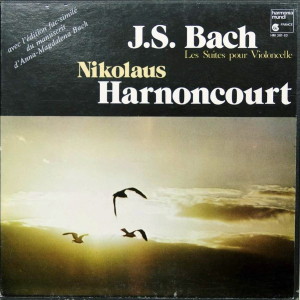 -300.jpg) 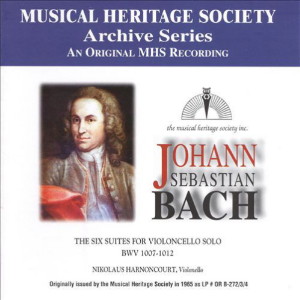 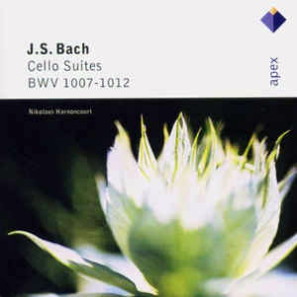 |
- Harmonia
Mundi France - HM 381-383 - 3 LP's - (p)
19?? - (First cover)
- Harmonia Mundi France - HM 381-383 - 3
LP's - (p) 19?? - (Second cover)
- Musical Heritage Society "Archive
Series" - 525776Z - 2 CD's - (c) 2000
- Warner "Apex" - 2564 60816-2 - 2 CD's -
(c) 2003
|
|
|
|
Nikolaus
Harnoncourt (1929-2016)
|

|

|
|